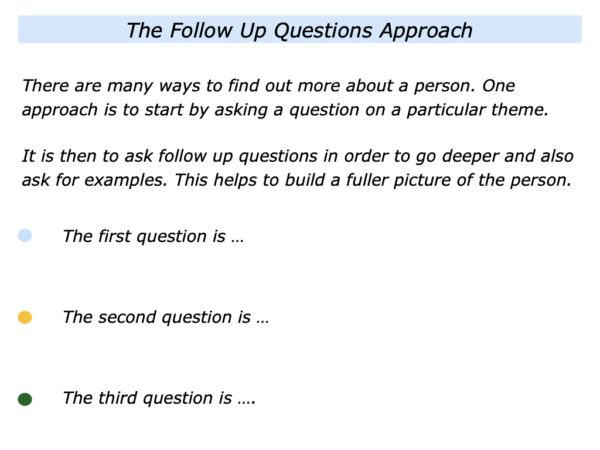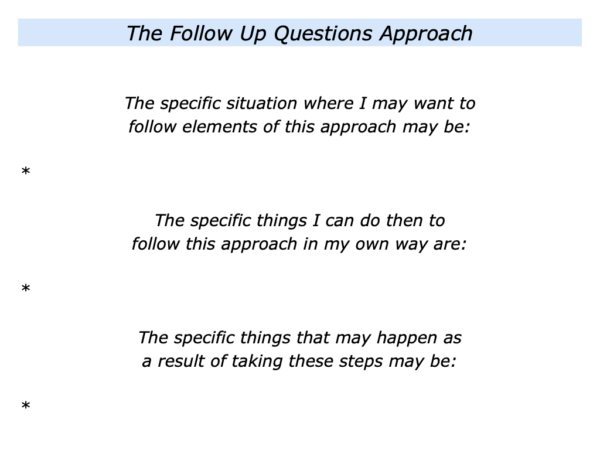
Imagine you are going to have a conversation with somebody or you are interviewing them for a role.
The first thing you say or the question you ask will set the tone for the conversation. You can then explore further by building on what they say or by asking follow up questions.
Good follow up questions can also help to provide a reality check to clarify what a person really means. This can be especially useful when interviewing candidates who apply for jobs or when talking with people who make sweeping statements.
Today’s fast moving world has encouraged people to use sound bites or speak in generalities. Such concepts can be alluring but sometimes it is can be useful to invite them to give concrete examples.
Political leaders, for example, often speak in slogans. When asked to explain, they jump to giving another slogan. Sometimes it is important to stop them and explore the implications of what they are saying.
Good journalists, for example, invite the politician to explain how their idea would be translated into action. They also ask them to explain the consequences – the pluses and minuses – of making this happen.
When interviewing a politician who is talking in sound bites they may say something like the following.
“Let’s explore this with you a little further. As far as I understand it, you are suggesting doing the following …? Is that right?
“I understand the principle, so let’s look at how this may work in practice. How would you translate this principle into action? What would you actually do to implement the idea?
“What would be the consequences of taking these steps? What would be the pluses and the minuses? How would you deal with the consequences?“
Follow up questions can help us to do a reality check. So let’s explore this process of asking questions to find out more about a person.
Follow Up Questions
In Interview Situations
Imagine that you are interviewing a person for a leadership role. They may have read books on leadership and come ready with various quotes.
Several years ago a company invited me to sit in on such an interview. At one point the candidate was asked about their leadership style. They come out with the following statement.
“I will communicate a clear vision and empower people to deliver it.”
The interviewing panel seemed to like this and were ready to move on to the next theme. Before they did so, however, I asked if it was okay for me to ask a few questions. These was along the following lines.
“I wonder if it is okay to ask a few things. Please accept that these questions are designed to explore how you will translate the ideas into action rather than to catch you out.
“It is also okay to reflect and take your time when considering the questions. Let’s start with a few questions about clarifying the team’s vision.
“What will you actually do to meet with the key stakeholders – such as your manager – and agree on the team’s specific goals? How will you make clear contracts about how you will keep the stakeholders informed regarding the progress towards achieving the goals?
“Let’s move on to working with the team. What will you do on your first day when meeting the team? What will you do to get to know each of the people and their strengths?
“How will you present the vision and the reasons for working towards it? How will you get their input to add to the vision? How make clear contracts with the team members about their best contributions to achieving the goals?
“How will you manage by outcomes rather than tasks? How will you make sure the team is on track when working towards the vision? What else will you to do build a successful team?
“Those are a lot of questions. I would like you to reflect, pick up on a few of the questions and share how you might translate some of these themes into action. Is that okay?”
We gave the candidate some time to reflect and then respond. Unfortunately they still answered with generalisations and a few more cliches. They were familiar with the concepts regarding leadership. But they found it hard to describe how they would translate these into concrete actions.
Later we met another candidate. They were able to describe some of the things they would actually do – in behaviour terms – to lead the team to success. This led to them being offered the role.
Follow Up Questions Can Uncover
A Person’s Successful Style
The follow up questions approach is one that can also be used to clarify a person’s successful style of working. Let’s look at one example.
Many years ago I was asked to interview a person who was applying for a leadership role. The company wanted to hire the person but was not sure if they would fit with the role that was advertised. Bearing this in mind, I invited the person to do the following things:
To describe when they had led a team successfully;
To describe the principles they followed when leading the team successfully;
To describe what they actually did – in behaviour terms – to translate these principles into action and lead the team successfully.
The person started by describing how they built a team from scratch, led a pioneering project and delivered success. At my request, they then described another project they had led to fruition.
The person’s leadership style soon became clear. Looking at their successful pattern, they made his best contribution when they took the following steps.
They found a place where they could build a successful prototype;
They agreed on the goals with their key stakeholders;
They set a deadline to work towards – because that was how they worked best – and for this to involve some sort of public launch;
They got some quick wins that reassured their stakeholders;
They built a team of committed people who wanted to achieve the goal;
They explained the professional deal clearly to people before they joined the team – people needed to know what they could and could not expect – then decide if they wanted to join the team;
They played to their strengths – which was focusing on the strategy and partnering with customers – and had a coordinator who kept things on track;
They continued to act as the flag bearer by keeping the stakeholders informed and also communicating through the media;
They kept people’s eyes on the compelling goal and flagged up where the team were on the journey;
They hit the deadline and sometimes did a public launch that involved customers who shared how the team had helped them to achieve success.
The leader’s style was more suited to doing pacesetting work rather than the advertised role. Bearing this in mind, the company invited him to consider running a new part of the business it was about to set-up.
This proved to be a much better fit. It produced a win for the person and a win for the company.
Let’s return to your own life and work. Can you think of a situation where you may want to use elements of the follow up questions approach? How can you do this in your own way?
If you wish, try tackling the exercise on this theme. This invites you to complete the following sentences.







Leave a Reply